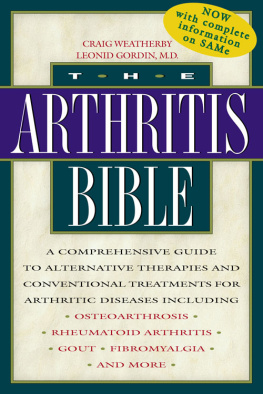LIVING WITH RHEUMATOID ARTHRITIS
A Johns Hopkins Press Health Book
Living
with
Rheumatoid
Arthritis
3rd
edition
TAMMI L. SHLOTZHAUER, M.D.

Note to the reader. This book is not meant to substitute for medical care of people with rheumatoid arthritis, and treatment should not be based solely on its contents. Instead, treatment must be developed in a dialogue between the individual and his or her physician. Our book has been written to help with that dialogue.
Drug dosage. The author and publisher have exerted every effort to ensure that the selection and dosage of drugs discussed in this text accord with current recommendations and practice at the time of publication. However, in view of ongoing research, changes in governmental regulations, and the constant flow of information relating to drug therapy and drug reactions, the reader is urged to check the package insert of each drug for any change in indications and dosage and for warnings and precautions. This is particularly important when the recommended agent is a new and/or infrequently used drug.
1993, 2003, 2014 Johns Hopkins University Press
All rights reserved. Published 2014
Printed in the United States of America on acid-free paper
9 8 7 6 5 4 3 2 1
Illustrations by Jacqueline Schaffer, except Figures 1 and 2. Figures 1 and 2 by Teresa Vaitkus.
Johns Hopkins University Press
2715 North Charles Street
Baltimore, Maryland 21218-4363
ww.press.jhu.edu
Library of Congress Cataloging-in-Publication Data
Shlotzhauer, Tammi L.
Living with rheumatoid arthritis / Tammi L. Shlotzhauer, M.D. Third edition.
pages cm
Includes bibliographical references and index.
ISBN 978-1-4214-1426-3 (hardcover : alk. paper) ISBN 1-4214-1426-0 (hardcover : alk. paper) ISBN 978-1-4214-1427-0 (pbk. : alk. paper) ISBN 1-4214-1427-9 (pbk. : alk. paper) ISBN 978-1-4214-1428-7 (electronic) ISBN 1-4214-1428-7 (electronic) 1. Rheumatoid arthritisPopular works. I. Title.
RC933.S445 2014
616.7227dc23
2013043619
A catalog record for this book is available from the British Library.
Special discounts are available for bulk purchases of this book. For more information, please contact Special Sales at 410-516-6936 or specialsales@press.jhu.edu.
Johns Hopkins University Press uses environmentally friendly book materials, including recycled text paper that is composed of at least 30 percent post-consumer waste, whenever possible.
The first edition was dedicated
with love and appreciation to our parents,
Richard and Carole Shlotzhauer,
Jean and Mickey McGuire

The second edition was dedicated to the late
Dr. James McGuire, friend and mentor

The third edition is dedicated to Gwen
Contents
Preface
If you or someone close to you has rheumatoid arthritis, you probably have many questions about what that diagnosis means. This book is an attempt to answer those questions. Living with Rheumatoid Arthritis describes all aspects of this condition, from the physical and the emotional to the practical. I hope the book will help you not only to understand rheumatoid arthritis but also to deal constructively with the changes it may bring in your life.
This book will also let you know that you are not alone. It has been estimated that two to three million Americans have rheumatoid arthritis, and about 200,000 people are newly diagnosed each year. Worldwide, about 1 percent of the population has this condition, which affects people of all races and ethnic groups. People of all ages can develop rheumatoid arthritis, although it most commonly first affects people in their twenties, thirties, and forties. Three times more women than men have the condition.
Most people with rheumatoid arthritis lead highly productive, full, and satisfying lives. More than anything else, I hope that this book will provide you with the information that you need to lead as productive a life as possible.
This book is not intended to take the place of your physician. I hope, though, that it will help you to formulate questions about your own health which you can then discuss with your doctor.
People have many different ways of coping with the knowledge that they have a chronic illness. Some people, for example, cope by denying that they have an illness; others put blind faith in their physicians and dont ask any questions or make any decisions. Others go from doctor to doctor trying anything for a curewhether its a proven, prescribed treatment or unconventional therapies. Some people cope by giving up and letting the illness control them: they dont follow their physicians or therapists advice because they think that nothing will help.
Studies have shown, however, that the people who cope best with a chronic illness are those who have an understanding of the disease process. This means that they learn everything they can about the illness so that they can take an active role in monitoring and caring for their own health.
What should you do when you learn that you have rheumatoid arthritis? First of all, educating yourself about rheumatoid arthritis and developing realistic expectations will help you overcome your fears and decrease your anxiety. We know that fear of the unknown creates great anxiety, just as uncertainty creates stress. This is because, more often than not, our imaginations create scenarios that are much worse than the reality could ever be. The truth, therefore, can often be reassuring.
Second, once you understand rheumatoid arthritis, you will be able to communicate more effectively with health care professionals; the time you spend with your physician, nurse, or therapist will be more helpful to both of you. You know your body better than anyone else, and you can become an expert on your arthritis. Then you can work closely with your health care providers in developing a therapeutic program that is tailor-made for you and that addresses your specific needs.
Finally, what you know about your rheumatoid arthritis will help you cope more effectively with the challenges it poses. For example, you will better understand the value of medication, exercise, joint protection, diet, and other treatments. Understanding the rationale behind each of the components of your treatment program may make you a more active participant in that program.
You cant read away your arthritis, of course, but you can play an important part in making decisions if you understand it. For all the reasons mentioned above, please read on and take a major role in mastering your arthritis.
The first part of this book discusses the physical aspects of rheumatoid arthritis, including changes in the joints and other parts of the body.. At the end of many chapters youll find information about additional resources, including organizations and readings. At the back of the book there is a glossary of terms used in this book. Words that are defined in the glossary are set in boldface type at their first use in each chapter. Other important terms in the text are in italic type at first use in the book.
Acknowledgments
Many individuals participated in the previous editions of this book, and I remain indebted to each of them. With deepest gratitude, I acknowledge my previous co-author, the late Dr. James McGuire, who made
Next page










